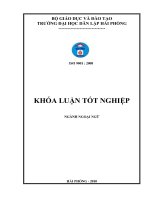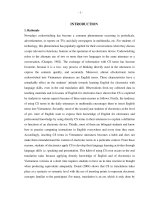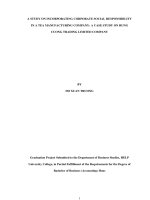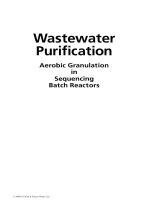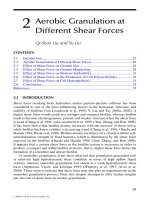Study on aerobic granular sludge formation in sequencing batch reactors for tapioca wastewater treatment
Bạn đang xem bản rút gọn của tài liệu. Xem và tải ngay bản đầy đủ của tài liệu tại đây (845.51 KB, 9 trang )
SCIENCE & TECHNOLOGY DEVELOPMENT, Vol 16, No.M1- 2013
Study on aerobic granular sludge
formation in sequencing batch reactors for
tapioca wastewater treatment
•
Nguyen Thi Thanh Phuong
University of Technology, VNU-HCM
•
•
Nguyen Van Phuoc
Thieu Cam Anh
Institute for Environment and Resources, VNU-HCM
(Manuscript Received on January 21st, 2013, Manuscript Revised May 04th, 2013)
ABSTRACT:
Aerobic granular sludge has attracted
extensive interest of researchers since the
90s due to the advantages of aerobic
granules such as good settling ability, high
biomass accumulation, being resistant to
high loads and being less affected by toxic
substances. Studies, however, which have
mainly been carried out on synthetic
wastewater, cannot fully evaluate the actual
ability of aerobic granules. Study on aerobic
granular
sludge
was
performed
in
sequencing batch reactors, using seeding
sludge taken from anaerobic sludge and
tapioca wastewater as a substrates. After 11
weeks of operation, the granules reached the
stable diameter of 2- 3 mm at 3.7
kgCOD/m3.day organic loading rate. At high
organic loads, in range of 1.6 - 5
kgCOD/m3.day,
granules
could
treat
effectively COD, N, P with performance of
93 – 97%; 65 – 79% and 80 – 95%,
respectively.
Keywords: Aerobic granular sludge, sequencing batch reactor, tapioca wastewater.
INTRODUCTION
Aerobic granular sludge formation and
applying them in practical wastewater treatment
was concerned for many years with some
advantages as follows: high Stability and
flexibility, Low energy requirements, Reduced
footprint, Good biomass retention, Reduced
investment and operational costs.
Traditionally, flocculated sludge with low
settling velocities is applied and large settling
tanks are needed to separate clean effluent from
the organisms. Besides large settling tanks,
Trang 40
separate tanks are needed to accommodate the
different treatment processes. Conventional
processes need many steps for nitrogen, COD
and phosphate removal, with large recycle flows
and a high total hydraulic retention time. Surplus
sludge from a municipal wastewater plant needs
different steps to dewater (e.g. thickening and
filterpressing) before it can be processed. To
overcome the disadvantages of a conventional
wastewater treatment plant, biomass has to be
TAẽP CH PHAT TRIEN KH&CN, TAP 16, SO M1- 2013
grown in a compact form, like aerobic granular
sludge.
The new aerobic granular sludge technology
has the ability to contribute to and improve the
biological treatment of wastewater. Compared to
present wastewater treatment plants, similar
efficiencies at lower costs can be achieved with
the compact aerobic granular sludge technology.
Granular sludge was first found in anaerobic
upflow anaerobic sludge blanket (UASB)
reactors to treat industrial wastewaters at the end
of the 1970s (Lettinga, 1980) [9]. Anaerobic
granular sludge consists mainly of methanogenic,
syntrophic acetogenic and various hydrolyticalfermentative bacteria and has been widely
applied in full-scale anaerobic reactors for wastewater treatment since the 1980s (Hickey, 1991)
[6]. Aerobic granular sludge is developed under
aerobic conditions and mainly used for the
aerobic degradation of organics and also for
nitrogen removal under aerobic and anoxic
conditions (Liu, 2004) [11]. Aerobic granular
sludge was first reported in a continuous aerobic
upflow sludge blanket reactor by Mishima and
Nakamura (1991) [12]. Aerobic granules with
diameters of 2 to 8 mm were developed, with
good settling properties. Aerobic granulation has
since been reported in sequencing batch reactors
(SBRs) bymany researchers(Morgenroth et al.,
1997; Beun et al., 1999; Peng et al., 1999; Etterer
and Wilderer, 2001; Tay et al., 2001a; Liu and
Tay, 2002)and has been used in treating highstrength wastewaters containing organics,
nitrogen
and
phosphorus,
and
toxic
substances(Jiang et al., 2002; Moy et al., 2002;
Tay et al., 2002e; Lin et al., 2003; Yang et al., in
press). Development of biogranules requires
aggregation of microorganisms. This study
attempted to observe the biomass prole and
reactor performances for the treatment of COD,
N and P with the presence of successfully
developed aerobic granular sludge.
MATERIALS
AND
PROCEDURES
Experimental set-up
EXPERIMENTAL
Experiments were performed in an open,
cylindrical column typed SBR with a working
volume of 5 L shown in Figure 1. Diameter,
height of this model and working height are 90
mm, 1000 mm and 800 mm, respectively.
Inuent was fed from a storage canister at a
loading rate of 1.2 kgCOD/m3.day. Aeration was
provided by means of air bubble diffusers at a
supercial air velocity of 5 L/min. The reactor
was operated in successive cycles of 3 h
comprehended a feeding period of 5 minutes, a
reaction period of 170 minutes, a settling period
of 2 minutes, an efuent withdrawal period of 3
minutes. Granular development stage was
operated in a time sequence of 5 minute filling,
170 minute aeration, 3 minute settling and 2
minute withdrawal. The short settling time
enhanced the granular development, enabled to
select and retain good biomass, primarily
granules which settling velocity is higher than 8
m/h.
Wastewater and seed sludge preparations
Experiments were conducted with tapioca
wastewater (after anaerobic tank) taken at
cassava starch-processing plants in Binh Phuoc
province (table 1). A suitable amount of nutrients
were supplemented to ensure a feed COD:N:P
ratio of 100:5:1. Prior to feeding the pH of the
mixed liquor was adjusted to a level of between
6.8 and 7.2 using 1M NaHCO3 or 1M NaOH
and 1M HCL.
The initial seeding sludge was anaerobic
sludge taken at Cassava starch processing factory
in Binh Phuoc province. The initial MLSS and
MLVSS concentration in the reactor were 7,273
mg/L, 4,500 mg/L, respectively. And the ratio
between MLVSS and MLSS was 62.3%.
Trang 41
SCIENCE & TECHNOLOGY DEVELOPMENT, Vol 16, No.M1- 2013
Table 1. Characteristics of tapioca wastewater
taken at cassava starch- processing plants in Binh
Phuoc
Parameters
Unit
Values
pH
-
5.4 0.3
COD
mg/L
2,842 308
BOD
mg/L
1,801 103
SS
mg/L
800 30
N-NH3
mg/L
19.2 3.5
Total Nitrogen
mg/L
72.3 5.8
mg/L
23 5
-
P-PO4
Figure 1. Experimental diagram
Analytical methods
The diameter of granules was determined
using a microscope model Olympus BX 51 with
an attached DP 71 camera. The sludge structure
and inner microbial organization were
characterized by Gram staining according to
Hucker and Conn methods. The microbial
morphology was observed by using Olympus BX
51 microscope afterward. Parameters such as
MLSS, MLVSS, COD, SVI, N-NO3-, N-NO2-,
Total Phosphorous, and alkalinity were carried
out according to Standard Methods [8].
Reactor operation
The experiment were carried out in two
stages: the first stage is sludge acclimation and
aggregation; the second one is granule maturation
and loading increasing. The reactor was operated
in batch mode, feeding and withdrawal
automatically. Each cycle had four steps: influent
filling, aeration, settling and effluent withdrawal.
RESULTS AND DISCUSSION
Sludge acclimation and aggregation stage
After one week of acclimation, anaerobic
biogas sludge has transformed completely into
aerobic sludge, shown by the color of sludge
(switch from black to dark brown); MLSS
increased from 3,584 mg/L to 4,932 mg/L, while
the ratio of MLVSS / MLSS increased from
50.1% to 75% (Figure 2).
Trang 42
Figure 2. Change of MLVSS / MLSS ratio at the
organic loading rate of 1.2 kgCOD/m3.day
Figure 3. Change of SS, VSS in SBR corresponding to
different operation time.
TAẽP CH PHAT TRIEN KH&CN, TAP 16, SO M1- 2013
Development of granules (from the 4 th week
onwards)
Figure 4. Change of COD at the OLR of 1.2 kg
COD/m3.day
Although biomass content reduced, COD
removal efficiency still increased from 70-81% to
a stable value of 91 - 93% at the end of the 2nd
week. At the same time, the ratio of MLVSS /
MLSS increased to value of 79 % at the 14th day.
Protozoa appeared in sludge such as Rotifer,
Cilia, and Flagella. At the 3rd week, the
settling time was maintained at the value of 3
minutes, biomass content decreased to 2754mg/L
as a result. However, COD removal efficiency
was still higher than 92% (Figure 4) and the
sludge volume index (SVI) was lower than 50
mL/g due to a drop of water content in sludge
and an increase in biomass density. It indicated
that aerobic granules were formed, which can
settle well and can treat the COD in wastewater.
At the end of 3rd week, biomass content
increased to 3000 mg/L because aerobic granular
systems promote better biomass retention
compared to initial sludge, in addition, VSS
concentration of effluent was under 100mg/L
(Figure 3 and 4).
At this time, the sludge color switched from
dark brown to light brown, sludge flocs had a
tendency to segregate. Granular core appeared in
streak shape, which had a diameter of 2mm
(Figure 5.e). Granules core was formed; the rate
of MLVSS / MLSS also increased rapidly and
reached the value over 80% at the end of the 3rd
week (Figure 2).
After 22 days of operation (the 4th week),
granules began to appear and increase about both
diameter and density afterward. The sludge in the
reactor was nearly completely granulized, and
visually no suspended biomass was present. Due
to the intensive mixing by aeration, the granular
sludge became spherical with a smooth surface.
At the 6th week, other forms of Rotifer and Cilia
appeared at higher density, and Rotifer was still
dominant (Figure 7.b, c). From week 7 to 9 (at
the loading of 2.5kgCOD/m3.day), the
microorganism as Protozoa, Rotifer, Cilia,
Flagella... in the granules gradually disappeared,
bacteria were the majority of granules (Figure
7.d).
Aerobic granules diameter reached 2mm after
6 weeks (Figure 5.d) and was stable until the 13 th
week. Most of the biomass was kept in the
reactor due to the good settle ability. After the
granules matured point, the granules were stable
and dynamically balanced in the maturation
phase. In this phase, the granular size might still
be shifting mainly between 2.0 and 3.0 mm, but
slowly and slightly, depending on the change of
operational conditions. And the mature granules
contained Filamentous in core; the next layers
were bacteria (mainly Gram negative), fungi, and
protozoa (Figure 7.e). At week 11, density of
bacteria in sludge was higher (Figure 7.f). From
week 11, when the organic loading rate increased
from 3.7 to 5kg COD/m3.day, granule diameter
continued to increase to 3mm (Figure 5f). The
change of granules diameter can be shown in
figure 6. When the diameter increased, however,
it was difficult for the substances to diffuse into
the granules core, leaded to broken granules if
the OLR was increased. As a result, the outside
layer was taken out while the black core
remained. Subsequently, the broken granules
recovered quickly, aggregated and increased the
Trang 43
SCIENCE & TECHNOLOGY DEVELOPMENT, Vol 16, No.M1- 2013
biomass. The OLR was stopped at 5 kg
COD/m3.day to avoid breaking granules.
At the organic loading rate of 2.5kg
COD/m3.day, VSS concentration increased to
6325 mg/L (at week 8), If the OLR increased to
3.7 - 5 kgCOD/m3.day, the value of VSS would
reach as high as 7360 mg/L at the loading of 5
kgCOD/m3.day (Figure 8). At OLR of 1.6
kgCOD/m3.day, SVI changed continuously in the
range of 38.4 - 39.6mL/g. As OLR increased to
2.5 kgCOD/m3.day, granules were formed
developed stably leads to SVI decreased from
38.4mL/g at 6th week to 26mL/g at 9th week.
When increasing the OLR up to 3.7
kgCOD/m3.day, granular sludge developed more
stably, tightly and heavily. It can be proved
through SVI, SVI decreased from the 26mL/g at
9th week to 22.6mL/g at 11th week.
When OLR increased to 5 kgCOD/m3.day,
more sludge can be formed and granules were
grown, as a result, SVI increased rapidly up to
64.69mL/g at 12th week and 65.61mL/g at 13th
week. Research results about SVI variation with
different OLR were matched with the studies of
Bui Xuan Thanh, Nguyen Phuoc Dan [21]. The
change of SVI at different loading was presented
in Fig 9.
In this study, the removal performances of
COD, NH4+, NO2-, NO3-, and total phosphorous
were investigated. The results were shown in
Figure 10, 12, 13, 14. The following would
explain the removal performance. At the
beginning, COD removal efficiency was 91.2%.
When increasing OLR to 1.6 kgCOD/m3.day, 2.5
kgCOD/m3.day, 3.7 kgCOD/m3.day, and 5
kgCOD/m3.day COD removal efficiency was
93.2%, 95.6%, 94.8, and 95.1%, respectively.
The COD removal efficiency was optimal at the
organic loading rate of 2.5 kgCOD/m3.day
(Figure 10). It reached the value of 95.6% while
MLVSS/MLSS ratio was over 90%. Moreover,
Trang 44
MLVSS/MLSS ratio was always over 80% at all
OLRs (Figure 11). These values were higher than
using conventional activated sludge, which
MLVSS/MLSS ratio was about 65 - 75% (Figure
11). The result also indicated that the biomass
density was quite high in granule structure.
Figure 5. Granules in different weeks (a. initial
granules; b. granule aggregation; c. forming granules;
d. growing granules; e. stable granules; f. granular
core)
Figure 7. Microorganism in the granules (a. Rotife; b.
Red Nematode; c. Cilia; d. protozoa around the
granules; e. granule structure; f. bacilli and cocci
bacteria)
TAẽP CH PHAT TRIEN KH&CN, TAP 16, SO M1- 2013
Figure 9. The variation of SVI at different organic
loading rates
Figure 11. The variation of MLVSS and MLVSS /
MLSS ratio at different organic loading rates
Figure 13. Change of NO2-, NO3- concentration at
different organic loading rates
Figure 10. COD removal efficiency at different
organic loading rates
Figure 12. Change of NH4+ concentration at different
organic loading rates
Figure 14. Variation of N concentration at different
organic loading rates
Trang 45
SCIENCE & TECHNOLOGY DEVELOPMENT, Vol 16, No.M1- 2013
Figure 15. Change of total phophorus concentration at different
organic loading rates
Phosphorous
removal
efficiency
was
presented in Figure 15. Concentration of influent
phosphorous increased with increasing OLR
corresponding to COD. At OLR of 2.5
kgCOD/m3.day corresponding to input P about
11mg / L, effluent P fell to less than 1.6mg/L,
effective treatment was about 80.0 - 95.2%. At
higher loading of 3.7 - 5 kgCOD/m3.day
corresponding influent P in water were 18 and
23mg/L, respectively, effluent P was always less
than 4 mg/L. Effective treatment was in range of
80.7-96.0% (Figure 15). The above results
indicated that P treatment in the model have been
rather stable. P was removed by the synthesis of
the bacterial cytoplasm. P was consumed rapidly
in the first minute of the aeration process. The
higher OLR was operated corresponding to the
higher P concentration, the longer time consumed
the P content. At OLR of 2.5 kgCOD/m3.day, P
was removed within 10 minutes of aeration
process, while at OLR of 3.7; 5 kgCOD/m3.day,
the time to treat P content up to 30 minutes. In
the remaining time of the aeration process, P
concentration in the reaction tank was changed in
a range of 0.1 mg/L to 1 mg/L due to
decomposition and synthesis of bacterial cell in
reaction tank when the substrate was depleted.
Trang 46
CONCLUSION
Aerobic sludge particles can be formed from
the initial culture anaerobic sludge without
carriers and with the short time for granulation
formation (only in 3 adaption weeks). When the
organic loading rate increased, the particle size of
granules also increased and gained a stable size
of 2 - 3 mm at OLR of 3.7 – 5 kgCOD/m3.day.
After 6 weeks of operation, the granules were
formed and grown with a range of 0.5 - 1.2mm.
Aerobic granules were in a good settling ability
with SVI in the range of 22.6 - 64.6mL/g, much
higher than conventional activated sludge with
SVI > 100 mL/g [22] leads to decrease the
settling time to 3 minutes. Due to the
accumulation of high level of biomass, granules
can remove efficiently organic matter at high
organic loading rate. At OLR of 5
kgCOD/m3.day, with F/M = 0.79 - 1.63 (L/day),
COD, nitrogen and phosphorus removal
efficiency can reach 92-98%, 60-68% and 8096%, respectively. The study opens a new
possibility for making granules and applications
of aerobic granules for high organic matter and
nutrients pollution wastewater treatment in
practice.
TAẽP CH PHAT TRIEN KH&CN, TAP 16, SO M1- 2013
Nghiờn cu to bựn ht hiu khớ trờn mụ
hỡnh SBR x lý nc thi ch bin tinh
bt khoai mỡ
Nguyn Th Thanh Phng
Trng i hc Bỏch Khoa, HQG-HCM
Nguyn Vn Phc
Thiu Cm Anh
Vin Mụi trng v Ti nguyờn, HQG-HCM
TểM TT:
Bựn ht hiờu khớ ó c rt nhiu nh
nghiờn cu quan tõm t nhng nm ca thp
niờn 90 do nhng u im ca bựn ht hiờu
khớ mang li nh kh nng lng tt, tớch ly
sinh khi cao, chiu c ti trng cao v ớt bi
nh hng bi cỏc cht c hi. Tuy nhiờn,
cỏc nghiờn cu ch yờu c tiờn hnh trờn
nc thi tng hp nờn cha ỏnh giỏ c
y kh nng x lý thc tờ ca bựn ht
hiờu khớ. ti nghiờn cu to bựn ht hiờu
khớ trờn nc thi thc tờ l nc thi tinh
bt mi v qua ú ỏnh giỏ hiờu qu x lý
cht hu c ca bựn ht hiờu khớ. Trong
nghiờn cu ny, bựn ht hiờu khớ c nuụi
cy trờn mụ hinh b phn ng tng m
(SBR) t bựn nuụi cy ban u l bựn ki khớ.
Sau 11 tun nuụi cy, bựn ht kớch thc n
inh t 2 3mm ti trng 3.7
kgCOD/m3.ngy.Vi ti trng hu c cao,
dao ng t 1.6 5 kgCOD/m3.ngy, bựn ht
x lý hiờu qu COD, N, P vi hiờu sut x lý
tng ng t 93 97%; 65 79% v 80
95%.
T khoa: bựn ht hiờu khớ, SBR, nc thi tinh bt mi.
REFERENCES
[1].
Beun JJ, Hendriks A, van Loosdrecht
MCM, Morgenroth E, Wilderer PA,
Heijnen JJ. Aerobic granulation in a
sequencing batch reactor. Water Res
1999;33:228390.
[4].
Roest H.F.R., Van Loosdrecht M.C.M. and
Uijterlinde C. (2004). Aerobic Granular
Sludge Technology, Alternative for
Activated Sludge Technology. Wat. Sci.
Technol.49(11-12), 1-9.
[2].
De Kreuk, M. K. (2006). Aerobic Granular
Sludge - Scaling-up a new technology.
Thesis, Department of Biotechnology,
Technical
University
Delft,
The
Netherlands. 199p.
[5].
De Kreuk, M.K. and De Bruin L.M.M.
(2004).
Aerobic
Granule
Reactor
Technology. London, IWA Publishing.
[6].
Etterer T, Wilderer PA. Generation and
properties of aerobic granular sludge. Water
Sci Technol 2001;43:1926.
[3].
De Bruin, L.M.M., De Kreuk M.K., van der
Trang 47
SCIENCE & TECHNOLOGY DEVELOPMENT, Vol 16, No.M1- 2013
[7].
Hickey R.F., Wu W.M., Veiga M.C., Jones
R.
[16]. Sludge in a sequencing batch reactor. Water
[8].
The start-up, operation and monitoring of
high-rate anaerobic treatment systems.
Water Sci Technol 24 (1991) 207–255.
[18]. Moy BYP, Tay JH, Toh SK, Liu Y, Tay
[17]. Res 31 (1997) 3191–3194.
STL. High organic loading influences the
physical characteristics of aerobic sludge
granules.
Lett
Appl
Microbiol
2002;34:407–12
Jiang HL, Tay JH, Tay STL. Aggregation
of immobilized activated sludge cells into
aerobically grown microbial granules for
the aerobic biodegradation of phenol. Lett
Appl Microbiol 2002;35:439–45.
[19]. Peng D.C., Benret N., Delgenes J.P.,
[10]. Lin YM, Liu Y, Tay JH. Development and
[20]. Tay JH, Liu QS, Liu Y. Microscopic
characteristics
of
phosphorousaccumulating granules in sequencing batch
reactor. Appl Microbiol Biotechnol
2003;62:430–5.
observation of aerobic granulation in
sequential aerobic sludge blanket reactor. J
Appl Microbiol 2001a;91:168–75.
[9].
[11]. Lettinga G., van Velsen AFM, Hosma
S.W., de Zeeuw W., Klapwijk A. Use of
the upflow sludge blanket (USB) reactor
concept
for
biological
wastewater
treatment,
especially
for
anaerobic
treatment. Biotechnol Bioeng 22 (1980)
699–734.
[12]. Liu Y, Tay JH. The essential role of
hydrodynamic shear force in the formation
of biofilm and granular sludge. Water Res
2002;36:1653–65 (24).
[13]. Liu Y., Tay J.H. State of the art of
biogranulation technology for wastewater
treatment. Biotechnol Adv 22 (2004) 533–
563.
[14]. Mishima
K.,Nakamura
M.
Selfimmobilization of aerobic activated sludge
- a pilot study of the process in municipal
sewage treatment. Water Sci Technol 23
(1991) 981–990.
[15]. Morgenroth E, Sherden T. Aerobic granular
Trang 48
Moletta R. Aerobic granular sludge - A
case report. Water Res 33 (1999) 890–893.
[21]. Tay JH, Liu QS, Liu Y. The effects of shear
force on the formation, structure and
metabolism of aerobic granules. Appl
Microbiol Biotechnol 2001b; 57:227–33.
[22]. Tay JH, Liu QS, Liu Y. The role of cellular
polysaccharides in the formation and
stability of aerobic granules. Lett Appl
Microbiol 2001c; 33:222–6
[23]. Yang SF, Tay JH, Liu Y. Effect of substrate
N/COD ratio on the formation of aerobic
granules. J Environ Eng 2003a [in press].
[24]. APHA.
Standard Methods for the
Examination of Water and Wastewater.
American Public Health Association,
Washington, DC (2005).
[25]. Bui Xuan Thanh, Nguyen Phuoc Dan.
Application of aerobic Granule for
Nitrogen removal of fishery wastewater.
[26]. Metcalf and Eddy. Wastewater Engineering
(1991).



